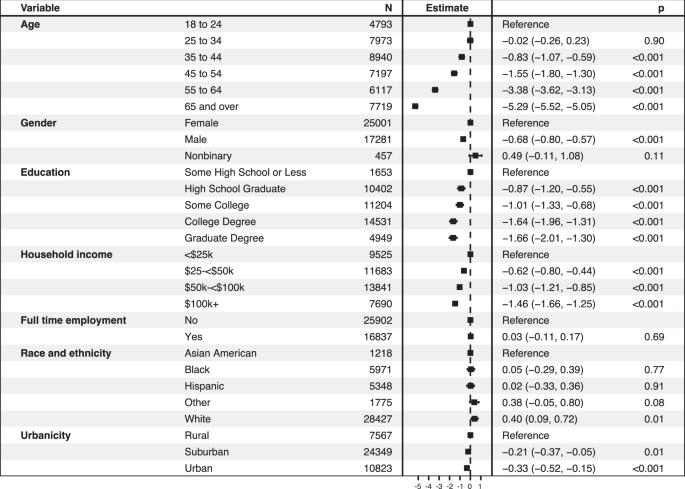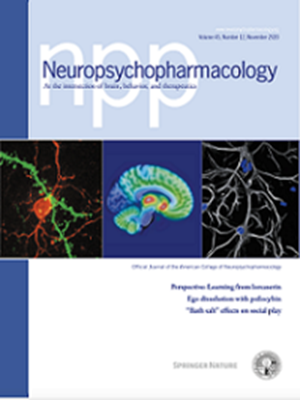Prevalence and correlates of irritability among U.S. adults
IF 6.6
1区 医学
Q1 NEUROSCIENCES
引用次数: 0
Abstract
This study aimed to characterize the prevalence of irritability among U.S. adults, and the extent to which it co-occurs with major depressive and anxious symptoms. A non-probability internet survey of individuals 18 and older in 50 U.S. states and the District of Columbia was conducted between November 2, 2023, and January 8, 2024. Regression models with survey weighting were used to examine associations between the Brief Irritability Test (BITe5) and sociodemographic and clinical features. The survey cohort included 42,739 individuals, mean age 46.0 (SD 17.0) years; 25,001 (58.5%) identified as women, 17,281 (40.4%) as men, and 457 (1.1%) as nonbinary. A total of 1218(2.8%) identified as Asian American, 5971 (14.0%) as Black, 5348 (12.5%) as Hispanic, 1775 (4.2%) as another race, and 28,427 (66.5%) as white. Mean irritability score was 13.6 (SD 5.6) on a scale from 5 to 30. In linear regression models, irritability was greater among respondents who were female, younger, had lower levels of education, and lower household income. Greater irritability was associated with likelihood of thoughts of suicide in logistic regression models adjusted for sociodemographic features (OR 1.23, 95% CI 1.22–1.24). Among 1979 individuals without thoughts of suicide on the initial survey assessed for such thoughts on a subsequent survey, greater irritability was also associated with greater likelihood of thoughts of suicide being present (adjusted OR 1.17, 95% CI 1.12–1.23). The prevalence of irritability and its association with thoughts of suicide suggests the need to better understand its implications among adults outside of acute mood episodes.


美国成年人易怒的普遍性和相关性。
本研究旨在描述易怒症在美国成年人中的流行程度,以及易怒症与重度抑郁症状和焦虑症状的共存程度。在 2023 年 11 月 2 日至 2024 年 1 月 8 日期间,对美国 50 个州和哥伦比亚特区 18 岁及以上的人进行了一次非概率互联网调查。调查采用加权回归模型来检验简易易怒测试(BITe5)与社会人口学和临床特征之间的关联。调查队列包括 42739 人,平均年龄 46.0(SD 17.0)岁;其中 25001 人(58.5%)为女性,17281 人(40.4%)为男性,457 人(1.1%)为非二元性别。共有 1218 人(2.8%)为亚裔美国人,5971 人(14.0%)为黑人,5348 人(12.5%)为西班牙裔,1775 人(4.2%)为其他种族,28427 人(66.5%)为白人。烦躁程度的平均值为 13.6(标准差为 5.6),评分范围为 5-30 分。在线性回归模型中,女性、年轻、教育程度较低和家庭收入较低的受访者易怒程度更高。在根据社会人口特征进行调整后的逻辑回归模型中,易怒程度与自杀念头的可能性相关(OR 1.23,95% CI 1.22-1.24)。在 1979 名在初次调查中没有自杀念头的人中,在随后的调查中被评估有自杀念头的人中,易怒程度越高,出现自杀念头的可能性也越大(调整后 OR 为 1.17,95% CI 为 1.12-1.23)。易怒的普遍性及其与自杀想法的关联表明,有必要更好地了解易怒在急性情绪发作之外的成年人中的影响。
本文章由计算机程序翻译,如有差异,请以英文原文为准。
求助全文
约1分钟内获得全文
求助全文
来源期刊

Neuropsychopharmacology
医学-精神病学
CiteScore
15.00
自引率
2.60%
发文量
240
审稿时长
2 months
期刊介绍:
Neuropsychopharmacology is a reputable international scientific journal that serves as the official publication of the American College of Neuropsychopharmacology (ACNP). The journal's primary focus is on research that enhances our knowledge of the brain and behavior, with a particular emphasis on the molecular, cellular, physiological, and psychological aspects of substances that affect the central nervous system (CNS). It also aims to identify new molecular targets for the development of future drugs.
The journal prioritizes original research reports, but it also welcomes mini-reviews and perspectives, which are often solicited by the editorial office. These types of articles provide valuable insights and syntheses of current research trends and future directions in the field of neuroscience and pharmacology.
 求助内容:
求助内容: 应助结果提醒方式:
应助结果提醒方式:


